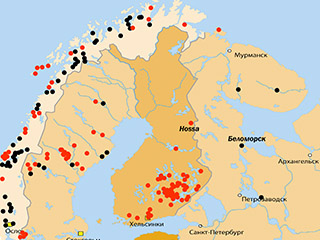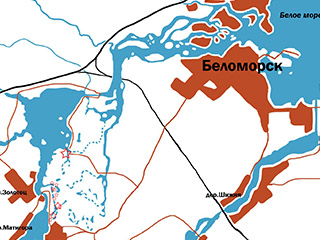
At the lower course of the Karelian Vyg River short of the town of Belomorsk one can find one of the greatest North European ancient rock art (petroglyphs) monuments.
A. M. Linevsky who discovered the Besovy Sledky rock in 1926 made the petroglyphs famous. In 1936, a Leningrad archeologist V. I. Ravdonikas discovered petroglyphs both in Zalavruga and some other areas. Karelian archeologists under the supervision of Yu. A. Savvateev continued the research work in the 1960 es. They discovered petroglyphs in New Zalavruga and on Erpin Pudas island. N. V. Lobanova (the language institute of the Karelian SC of the RAN) has been doing her research in the field. Some new petroglyph groups and clusters were discovered. Currently, more than 3000 images located in 13 sites are registered.
Belomorsk rock art engravings go back to the Neolithic era. They were made 6.5 thousand years ago when the climate was warmer than nowadays. The petroglyphs are various in motifs and extremely impressive in terms of their engraving manner. Some of the Zalavruga compositions are classified as world rock art masterpieces. Most of the engravings have the length of 20–40 centimeters and certain images are 3 meter length. The ancient artists used some quarts tools called hammer stones to make 1.5–3.5 millimeters depth engravings.
Zalavruga
Zalavruga, containing about 2000 engravings, is the richest petroglyph monument in European Russia. The first two hundred images were discovered by V.I.Ravdonikas in 1936. In
Groups found on islands
Four separated petroglyph clusters are found on two small nameless islands located downstream from the island of Erpin Pudas. The clusters contain both separate images
Erpin Pudas
There are 4 petroglyph groups on the island. The two first petroglyph groups were discovered by V.I.Ravdonikas’s expedition in 1936. The third group, which is the biggest one and contains about one hundred engravings, was discovered by Yu.A.Savvateev in
Besovy Sledky (pavilion)
The petroglyphs were discovered in 1926 by A.M.Linevsky on the northern cap of the island of Shoyrukshin. This petroglyph group was protected against weathering with a special pavilion constructed in 1968. The petroglyphs cover the rock area of 12.5 square meters. The rock surface is quite even and slopes towards the river. The rock height is about


